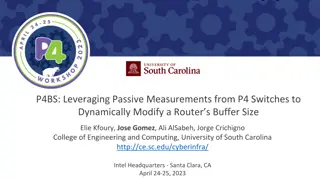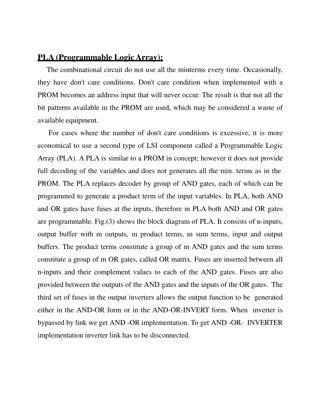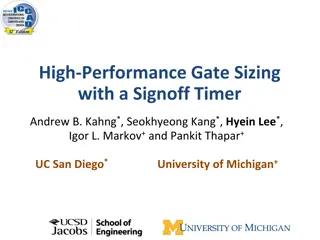Dynamic Router Buffer Sizing using Passive Measurements and P4 Programmable Switches
Routers and switches' buffer sizing impacts network performance. Learn about buffer sizing rules, Stanford rule applicability, and the benefits of P4 programmable switches in dynamic router buffer sizing.
Download Presentation

Please find below an Image/Link to download the presentation.
The content on the website is provided AS IS for your information and personal use only. It may not be sold, licensed, or shared on other websites without obtaining consent from the author.If you encounter any issues during the download, it is possible that the publisher has removed the file from their server.
You are allowed to download the files provided on this website for personal or commercial use, subject to the condition that they are used lawfully. All files are the property of their respective owners.
The content on the website is provided AS IS for your information and personal use only. It may not be sold, licensed, or shared on other websites without obtaining consent from the author.
E N D
Presentation Transcript
Dynamic Routers Buffer Sizing using Passive Measurements and P4 Programmable Switches Elie Kfoury Elie Kfoury1, Jorge Crichigno1, Elias Bou-Harb 2, Gautam Srivastava 3 1 University of South Carolina, SC 2 The University of Texas at San Antonio, TX 3 Brandon University, CA 1 2/25/2025
Agenda Introduction Buffer sizing rules Stanford rule Programmable switches Proposed system Results and evaluation Conclusion 2 2/25/2025 Dynamic Router s Buffer Sizing using Passive Measurements and P4 Programmable Switches
Introduction Routers and switches are designed to include packet buffer The size of buffers imposes significant implications on the performance of the network Large buffers -> excessive delays, Bufferbloat Small buffers -> packet drops, potential low link utilization 3 2/25/2025 Dynamic Router s Buffer Sizing using Passive Measurements and P4 Programmable Switches
Buffer sizing rules General rule-of-thumb: Bandwidth-delay product Buffer = C * RTT C is the capacity of the port and RTT is the average round-trip time (RTT) Stanford rule: Buffer = ? ??? ? N is the number of long (persistent over time) flows traversing the port Statistical multiplexing Tiny buffer: Few dozen KB 10-20% drop in link utilization Appenzeller et al., Sizing Router Buffers. 4 2/25/2025 Dynamic Router s Buffer Sizing using Passive Measurements and P4 Programmable Switches
Stanford rule applicability Setting the router s buffer size to BDP/ N would require determining the current average RTT and the number of flows This could be achieved by passively capturing traffic crossing the router and forwarding it to a general-purpose CPU Cannot cope with high traffic rates, especially in high-speed networks Sampling techniques (e.g., NetFlow) cannot be applied either since they are not accurate enough and often lose measuring information1 1Spang, Bruce, and Nick McKeown. "On estimating the number of flows." Stanford Workshop on Buffer Sizing. 2019. 5 2/25/2025 Dynamic Router s Buffer Sizing using Passive Measurements and P4 Programmable Switches
Overview P4 switches P4 switches permit programmer to program the data plane Customized packet processing High granularity in measurements Per-packet traffic analysis and inspection If the P4 program compiles, it runs on the chip at line rate Programmable chip P4 code 6 2/25/2025 Dynamic Router s Buffer Sizing using Passive Measurements and P4 Programmable Switches
Proposed system Dynamically modify the buffer size of routers based on measurements collected on programmable switches 1. Copy of the traffic is forwarded to a programmable switch by passively tapping on routers ports 2. The programmable switch identifies, tracks, and computes the RTT of long flows 3. The programmable switch modifies the legacy router s buffer size 7 2/25/2025 Dynamic Router s Buffer Sizing using Passive Measurements and P4 Programmable Switches
RTT calculation Relate the TCP sequence (SEQ) and acknowledgement (ACK) numbers of incoming and outgoing packets1 The RTT can then be inferred by calculating the time difference between the two packets In reality, devices might not acknowledge every packet 1Chen, Xiaoqi, et al. "Measuring TCP round-trip time in the data plane." Workshop on Secure Programmable Network Infrastructure. 2020. 8 2/25/2025 Dynamic Router s Buffer Sizing using Passive Measurements and P4 Programmable Switches
Long flows counting The number of flows in the buffer size formula (BDP / N) -> long flows sharing the bottleneck link1 Short flows on the other hand are not considered since they have very small effect on the buffer1 Need to differentiate between the two 1Appenzeller, Guido, Isaac Keslassy, and Nick McKeown. "Sizing router buffers." ACM SIGCOMM Computer Communication Review 34.4 (2004) 9 2/25/2025 Dynamic Router s Buffer Sizing using Passive Measurements and P4 Programmable Switches
Implementation and evaluation Topology and experimental setup Different congestion control algorithms1 iPerf3 Default buffer size of the router is 200ms2 Edgecore Wedge100BF- 32X, ASIC chip (Intel s Tofino) 1Mishra et al. The great Internet TCP congestion control census, ACM on Measurement and Analysis of Computing Systems, 2019 2N. McKeown et al. Sizing router buffers (redux), ACM SIGCOMM Computer Communication Review, vol. 49, no. 5 10 2/25/2025 Dynamic Router s Buffer Sizing using Passive Measurements and P4 Programmable Switches
Implementation and evaluation Two scenarios are considered: 1. Default buffer size on the router, without any dynamic modification 2. P4 switch measures and modifies the buffer size of the router 11 2/25/2025 Dynamic Router s Buffer Sizing using Passive Measurements and P4 Programmable Switches
Results Multiple long flows, CCAs, and propagation delays Average link utilization Average fairness index Average RTT 12 2/25/2025 Dynamic Router s Buffer Sizing using Passive Measurements and P4 Programmable Switches
Results Performance of short flows sharing the bottleneck with long flows 1000 short flows are arriving according to a Poisson process Flow size distribution resembles a web search workload (10KB to 1MB) Background traffic: 200 long flows, propagation delay = 50ms 13 2/25/2025 Dynamic Router s Buffer Sizing using Passive Measurements and P4 Programmable Switches
Results Long flows with different emulated propagation delays 100 long flows, divided into four groups of each 25 flows each Each group starts three minutes after the other Cubic congestion control algorithm 14 2/25/2025 Dynamic Router s Buffer Sizing using Passive Measurements and P4 Programmable Switches
Conclusion This paper presented a scheme that dynamically modifies the size of the router s buffer The scheme uses passive measurements collected by programmable P4 switches Experiments conducted on real hardware demonstrate the improvements in the RTT, packet loss rate, fairness, and FCT of flows 15 2/25/2025 Dynamic Router s Buffer Sizing using Passive Measurements and P4 Programmable Switches
Acknowledgement Thanks to the National Science Foundation (NSF)! Activities in the CI Lab at the UofSC are supported by NSF, Office of Advanced Cyberinfrastructure (OAC), awards 1925484 and 2118311 16 2/25/2025 Dynamic Router s Buffer Sizing using Passive Measurements and P4 Programmable Switches
Thank You Contact info for further questions ekfoury@email.sc.edu jcrichigno@cec.sc.edu CyberInfrastructure Lab (CI Lab) website http://ce.sc.edu/cyberinfra/ 17 2/25/2025 Dynamic Router s Buffer Sizing using Passive Measurements and P4 Programmable Switches























